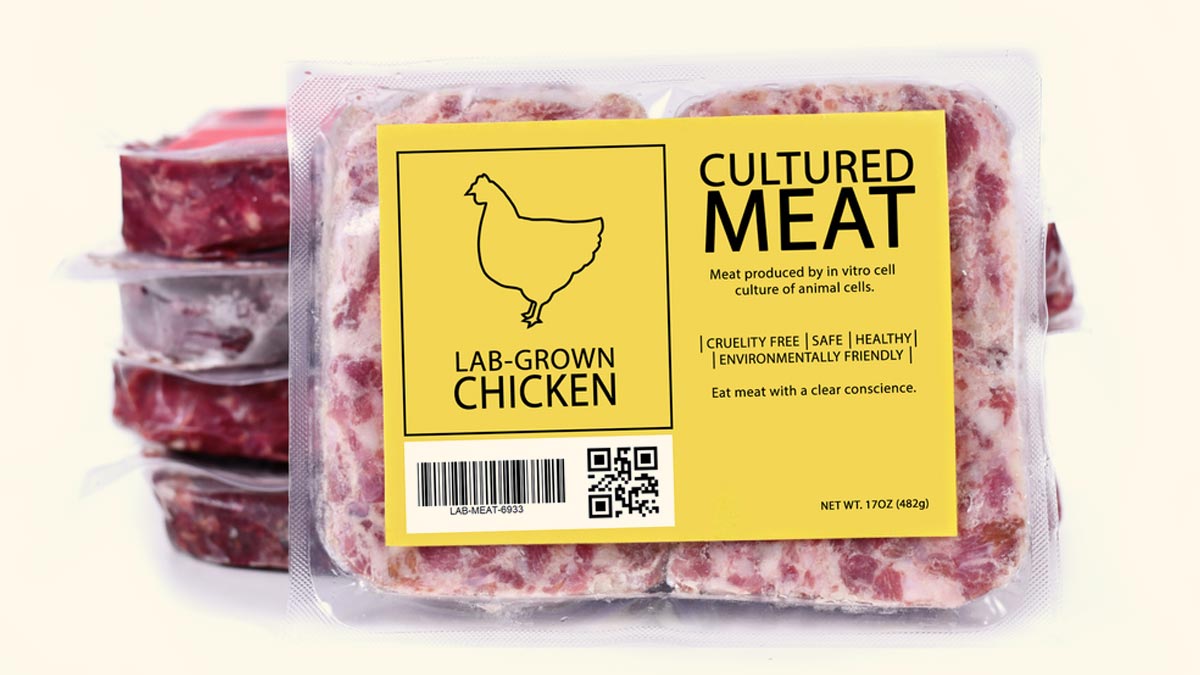
Is there a way to enjoy the benefits of meat without having to eat animals? The question may sound absurd, however, with lab-made meat you can eliminate animal suffering. Not only this, the Greenhouse Gas (GHG) emissions based on life cycle and other environmental problems will also be lowered. To understand more about lab-made chicken, we spoke to our expert Dr Pradeep Mahajan, Regenerative Medicine Researcher and Founder of StemRx BioScience Solutions India, who explained its processing, benefits, and challenges.
Table of Content:-

“Lab-made meat includes creating animal muscle and fat from cells in a lab setting without the use of animal husbandry practices. It aims to replicate the natural process of muscle tissue growth that occurs in animals but in a regulated and optimised laboratory environment”, said Dr Mahajan.
“It produces meat that is biologically identical to conventionally farmed meat where slaughtering, pain, and discomfort of animals are avoided and with possibly lower environmental impact and enhanced animal welfare”, he added.
The US Food and Drug Administration (FDA) declared in 2022 that there were 'no further questions' about the safety of the lab-grown meat, which turns chicken cells into flesh in a regulated environment.
Previously thought to be science fiction, lab-grown meat is now a reality. For many years, PETA (People for Ethical Treatment of Animals) has supported lab-grown meat and funded in-vitro research. PETA is an animal rights organisation that opposes the use and abuse of animals.

How Is Lab-Made Meat Made?
Cell-based meat, sometimes referred to as lab-grown meat, is produced using in-vitro utilising techniques, such as tissue engineering, cellular biology, and bioprocessing. Dr Mahajan explained the processing of lab-made meat as follows:
- Extraction of cells from a living animal, obtained from an animal biopsy, which acts as the source of the animal cells, is the first step in producing lab-grown meat.
- The muscle cells are then put in a nutrient-rich culture media known as a growth medium, which provides the environment for cell growth and development.
- The cells proliferate and differentiate under a set of advantageous circumstances, resulting in the formation of muscle fibres.
- Scientists use scaffolding techniques, such as biodegradable scaffolds or 3D printing, to create intricate 3-dimensional meat structures.
- These techniques imitate the natural creation of tissues to produce meat products with the desired composition and texture while providing structural support to the developing cells and tissues.
Also Read: Plant-Based Protein: Expert Lists Protein Options You Should Eat For Athletic Performance
Benefits of Lab-Grown Meat
Dr Mahajan outlines several health-related benefits associated with lab-grown meat as follows:

Health Advantages
- Elimination of crowded and unhygienic agricultural practices
- Reduced risk of food-borne illnesses due to careful inspection of lab-grown cells
Animal Welfare
- Prevention of diseases in poultry, such as Marek's Disease and Avian Influenza
- Reduction in animal suffering and health risks for consumers
Challenges Faced by Lab-Grown Meat
Despite its promising advantages, lab-grown meat encounters several challenges that need to be addressed for widespread acceptance. Some of them listed by the expert are:
.jpg)
Consumer Acceptance
Cell-cultivated alternatives are yet to achieve flavour, texture, appearance, and cost parity with conventional meat. Cultured meat's perception as ‘artificial’ or ‘unnatural’ may influence customer readiness to accept these goods.
Cost
The cost of cell-cultivated meat is projected to remain high, owing to the sophisticated and resource-intensive cell-culturing method. Hence, costs associated with quality control and scalability procedures could increase.
Scalability
It is difficult to scale up production while maintaining consistency and product quality because it is currently limited to small quantities. Reaching scalability requires finding a suitable cell culture medium and creating effective and affordable bioreactor systems.
Resources
To assure the quality of the final output, researchers need high-quality cells, appropriate growth media, and other resources.
Environmental Effect Concerns
If highly refined growth media are needed, the environmental effect of cell-cultivated meat production might be greater than that of conventional meat production.
Intellectual Property and Patent Issues
Companies and researchers are submitting patent applications for several methods and technologies used in the cultivation of meat. The expansion and development of the sector will be impacted by the resolution of intellectual property conflicts and the maintenance of equitable access to technology.
Bottomline
Dr Mahajan concluded, “This groundbreaking achievement not only promises to revolutionise the way we consume meat but also holds the potential to alleviate the environmental strain caused by livestock farming.”
[Disclaimer: This article contains information provided by a registered healthcare professional and is for informational purposes only. Hence, we advise you to consult your expert before making any changes to your diet, especially if you are dealing with any health conditions.]
Also watch this video
How we keep this article up to date:
We work with experts and keep a close eye on the latest in health and wellness. Whenever there is a new research or helpful information, we update our articles with accurate and useful advice.
Current Version